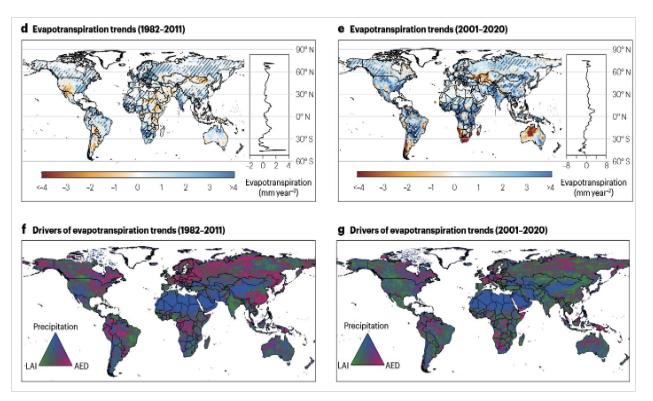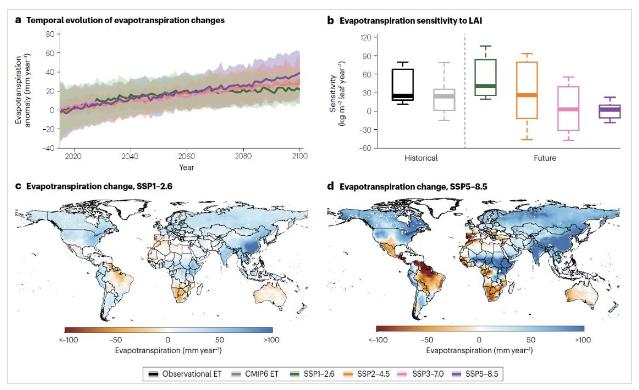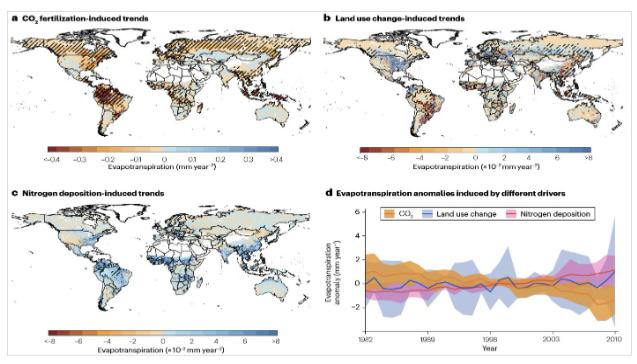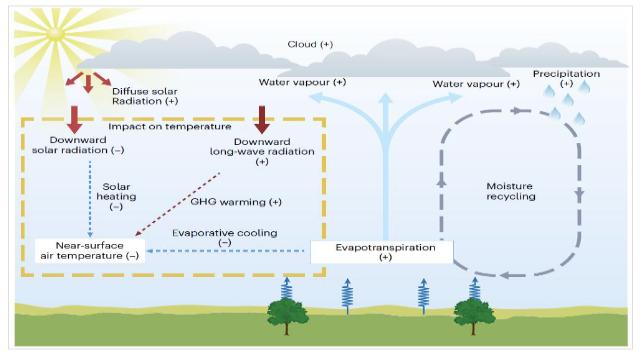Evapotranspiration serves as a crucial link in the global water-carbon-energy coupled cycle, playing a pivotal role in quantifying the hydrological cycle's response to global changes. Against the backdrop of global warming and intensified hydrological cycles, global evapotranspiration exhibits clear interannual and seasonal variations. However, due to the complex spatiotemporal variations of evapotranspiration, numerous influencing factors, and limited in-situ observations, there exist significant differences in the estimates of evapotranspiration obtained through various methods. This leads to considerable uncertainty in the current assessments of global evapotranspiration spatiotemporal changes. Simultaneously, the large-scale greening of vegetation has been one of the most prominent features of global changes in recent decades. Nevertheless, the evapotranspiration effects of vegetation greening remain unclear. The uncertainty in the evapotranspiration estimates, coupled with a lack of a clear understanding of how evapotranspiration responds to key global change processes, significantly restricts our scientific understanding of how the hydrological cycle responds to global changes. This uncertainty also poses significant challenges to the assessment of freshwater resource sustainability, the formulation of agricultural irrigation systems, the prediction of drought events, and the monitoring of ecosystems under the backdrop of global changes.
In response to the aforementioned issues, Associate Professor YANG Yuting’s team from the Department of Hydraulic Engineering at Tsinghua University systematically reviewed existing observational evidence and model results. They analyzed the spatiotemporal characteristics of global evapotranspiration and its driving factors since the 1980s, with a particular focus on discussing the impact of vegetation changes on evapotranspiration. Additionally, they assessed the feedback effects of evapotranspiration changes on the climate system. The achievement, titled “Evapotranspiration on a Greening Earth,” was published online on August 22, 2023, in Nature Reviews Earth & Environment (https://www.nature.com/articles/s43017-023-00464-3).
By synthesizing results from multiple sources of observation and models, the global land surface average annual evapotranspiration was quantified as 520±31 mm yr-1, approximately 66% of the global land surface average annual precipitation, and 47% of the average annual net radiation. Meanwhile, since the 1980s, there has been an accelerating upward trend in global land surface evapotranspiration. Over the 30 years from 1982 to 2011, global land surface evapotranspiration increased on average by 0.66 ± 0.38 mm per year. In the first two decades of this century (2001-2020), the annual average increase rose to 1.19 ± 0.31 mm. Vegetation greening has played a dominant role in the global increase of evapotranspiration, contributing 39 ± 18% and 62 ± 36% to the increase in evapotranspiration during the two respective periods. In addition to long-term trends, the seasonal variations in vegetation also lead to seasonal changes in evapotranspiration. Specifically, there is a significant upward trend in evapotranspiration during the spring and autumn seasons, associated with the earlier greening of vegetation in spring and delayed leaf fall in autumn. Meanwhile, the proportion of evapotranspiration during the summer season noticeably decreases in the annual evapotranspiration. Based on climate model simulation results, the paper points out that under future climate change scenarios, global land surface evapotranspiration will continue to exhibit a significant upward trend, with vegetation greening remaining a primary driving factor. However, compared to historical periods, the future impact of vegetation greening on the increase in evapotranspiration is expected to decrease.

Historical trends and driving factors of global land surface evapotranspiration.

Changes in global land surface evapotranspiration under future climate change scenarios.
The paper further discusses the impact of key driving factors of vegetation change, such as atmospheric CO2 fertilization effects, land-use change, variations in meteorological elements, and nitrogen deposition, on evapotranspiration. The increase in atmospheric CO2 concentration is the primary driver for global vegetation greening. However, the rise in atmospheric CO2 concentration exhibits two contrasting characteristics regarding the evapotranspiration effects of vegetation fertilization: from the structural response of vegetation to CO2, an increase in vegetation coverage and root growth leads to higher evapotranspiration. On the other hand, the physiological response of vegetation to CO2, specifically the decrease in stomatal conductance, has an inhibitory effect on evapotranspiration. Overall, in areas where structural responses dominate with low vegetation coverage, CO2 fertilization mainly promotes evapotranspiration. Conversely, in areas dominated by physiological responses with high vegetation coverage, the inhibitory effect of CO2 fertilization on evapotranspiration is more pronounced. The impact of land-use change on evapotranspiration is complex and challenging to quantify, with a very weak signal at the global scale. However, different types of land-use changes, such as large-scale vegetation planting, deforestation, expansion of cultivated land, agricultural irrigation, forest fires, etc., significantly impact evapotranspiration at the local/regional scale. Additionally, changes in meteorological elements and nitrogen deposition primarily promote evapotranspiration at the global scale, but their impact is limited.

The changes in evapotranspiration induced by CO2 fertilization, land-use change, and nitrogen deposition.
The changes in evapotranspiration caused by vegetation greening will have an impact on the local/regional climate. Evapotranspiration affects precipitation by altering the total amount of water vapor transferred from the land to the atmosphere and influencing the stability of the atmospheric boundary layer. The increased evapotranspiration caused by vegetation greening enhances local water vapor circulation and also increases moisture input to downwind regions, resulting in increased precipitation. Simultaneously, evapotranspiration influences near-surface air temperature through direct and indirect pathways. On one hand, evapotranspiration directly leads to a decrease in near-surface air temperature through the evaporative cooling effect. On the other hand, the increase in atmospheric water vapor content due to rising evapotranspiration indirectly affects near-surface air temperature by influencing the transmission of land-atmosphere shortwave and longwave radiation. Overall, during historical periods, the increase in evapotranspiration caused by vegetation greening led to a weak but significant downward trend in near-surface air temperature.

The impact of evapotranspiration on precipitation and temperature
The paper concludes by stating that, despite significant advancements in understanding the evapotranspiration process and its response to environmental changes, there are still numerous issues that require urgent attention in future research. These include improving model accuracy in simulating the evapotranspiration process, especially its components, enhancing the scientific understanding of the mechanisms behind evapotranspiration responses to environmental factors, particularly the increase in atmospheric CO2 concentration. Additionally, there is a need to strengthen long-term observations and model validations of the evapotranspiration process, especially its components. Furthermore, the development of evapotranspiration data fusion techniques based on a combination of multiple observations and physical models is essential. The research review addresses recent controversies regarding global trends in evapotranspiration, elucidates the dominant role of vegetation greening, summarizes, and analyzes the impact of various driving factors of vegetation change on evapotranspiration, reveals the feedback effects of evapotranspiration changes on the atmospheric system, and outlines future research directions. This not only promotes the study of evapotranspiration changes from a multi-sphere Earth system perspective but also provides substantial scientific evidence for a deeper understanding of how the hydrological cycle responds to global changes.
Associate Professor YANG Yuting from the Department of Hydraulic Engineering at Tsinghua University serves as both the first and corresponding author of the paper, while Professor YANG Dawen from the same department serves as a co-corresponding author. Domestic collaborators on the paper include Professor ZHANG Lu from Wuhan University, Researcher ZHANG Yongqiang, and Associate Researcher ZHANG Xuanze from the Institute of Geographic Sciences and Natural Resources Research, Chinese Academy of Sciences, Academician PIAO Shilong from Peking University, and Professor ZHANG Baoqing from Lanzhou University. Postdoctoral fellows GUO Hui and GAN Rong, as well as Ph.D. student TU Zhuoyi from the Department of Hydraulic Engineering at Tsinghua University, also contributed to the relevant work of the paper. The research received funding from the National Natural Science Foundation of China and other projects.